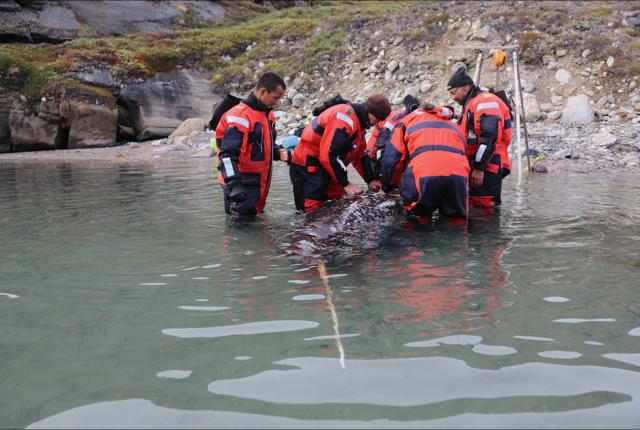A Daily Audio Diary Of The Narwhal
9:31 minutes

 This is a part of Oceans Month, where we explore the science throughout the world’s oceans and meet the people who study them. Want to dive in with us? Find all of our stories here.
This is a part of Oceans Month, where we explore the science throughout the world’s oceans and meet the people who study them. Want to dive in with us? Find all of our stories here.
The narwhal has captured the imaginations of many people. These unicorns of the sea can be pretty elusive—there aren’t any in captivity, and not much is known about the whales.
Now, scientists have outfitted a group of narwhals with audio tags that allowed them to capture their echolocation and communication sounds. Susanna S. Blackwell, a biologist and author on the study, which was published in PLOS ONE, talks about what these sounds can tell us about the daily life of the narwhal, and how manmade sounds could affect the whales. Listen to some of the sounds of the narwhal below.
[Summer is almost here. That means it’s time to dust off those binoculars and look up.]
Susanna S. Blackwell is a senior scientist at Greeneridge Sciences, Inc., and a research associate at UC Santa Cruz in Santa Barbara, California.
IRA FLATOW: OK. I want you to listen carefully. Can you ID this sound?
[CLICKING]
No, that’s not the clock from 60 Minutes at the beginning of the show. This is the sound of a narwhal. The ocean is filled with fascinating sea creatures, and the narwhal is one that seems to capture the imagination of a lot of people. Kind of looks like a beluga whale, but it has that long horn.
And narwhals are pretty elusive. There aren’t any in captivity and not much is known about the whales. Let’s let people’s imagination run wild. Boy, they call them unicorns of the sea because they think they are when they see one. Scientists are interested in them too. And a team of researchers tagged six narwhals with acoustic tags to create a sort of narwhal audio diary.
And the results were published this week in a journal, PLOS One. My next guest is one of the authors on that study. Susanna Blackwell is a biologist senior scientist at the Greeneridge Sciences based in Santa Barbara. Welcome to Science Friday.
SUSANNA BLACKWELL: Thank you.
IRA FLATOW: Now is it true that narwhals live only in the Arctic?
SUSANNA BLACKWELL: Yes. Not in the Antarctic as many people ask me.
IRA FLATOW: Oh. And so we know that area is rapidly changing. Does that mean the narwhals are going to be affected also?
SUSANNA BLACKWELL: Well, that’s what we’re trying to figure out. We know that right now they have a couple of potential issues facing them. One is the fact that the waters are getting warmer and there is less ice in the summer. And so their environment is in– their environment is changing. The other is that, because of that change, because of the lack of ice in the summer, there is the potential human activities that may come and take place. So there’s going to be a change in the sound of their environment too.
IRA FLATOW: So what do they depend on to live in the Arctic? Is it the ice that’s there?
SUSANNA BLACKWELL: Well, it’s not really well known. They seem to be very linked to the pack ice. Like, in the winter you would think, well, maybe they could go south where there is no pack ice yet. All winter long they remain in the pack ice in very dense ice where they dive to great depths and forage for fish and stuff.
IRA FLATOW: And now you attached tags that can record audio to six different narwhals to get a sense of what kind of sounds they’re making, and we have some of those sounds here. Let’s hear some of the sounds you recorded. Let’s play this clip first.
[NARWHAL NOISES]
Wow. Wow– sounds almost like Weddell seals at some point. It’s like all kinds of diving sounds. Tell us what we were listening to.
SUSANNA BLACKWELL: Yeah. So that’s actually one of my favorite clips. It occurred very close to the surface and it involved several narwhals. We don’t really know how many, but we definitely know there were more than just the animal that was carrying the tag. I wish I spoke narwhal. I wish I knew what they were saying. And you listen to the clip, you can hear all kinds of different sound– whistles and burst pulses and squeaky sounds and such. So it’s a form of communication, we think that much is for sure, but what they’re saying? We don’t know.
IRA FLATOW: Yeah. And after the narwhals were tagged and released, they didn’t make any sounds for almost up to a full day, right?
SUSANNA BLACKWELL: Yeah. That’s right. I think they were frazzled by– to instrument them, we have to catch them in the net. And they are actually animals that are hunted in the Arctic by the natives, so they may have thought their last moment had come. I don’t know. In any event, we remove them from the net and put the tags, and then release them.
So it’s interesting to see that they don’t just go straight back to behaving normally. They actually were silent for anything between 9 and 35 hours or so– 23 hours on average before they started echolocating and seemingly behaving normally.
IRA FLATOW: I’m Ira Flatow. This is Science Friday from WNYC Studios talking with Susanna Blackwell about her narwhal research. And we have a really interesting question on phones. Let’s go to the phones. Let’s go to Berkeley. Hi, welcome to Science Friday.
SPEAKER 1: Hi there. I’m very interested in ocean issues and ocean subjects. A lot has come out about narwhal tusks and how they’re used in perceiving the world around them. I was wondering if there was any correlation between their horn and sound production and reception?
SUSANNA BLACKWELL: Well, in these first six animals that we instrumented, only one of them was a male. And at this point, we have not looked at any of those questions. So that may be something for the future. I’m not sure. But there are several thoughts on what the tusk is for. And I think our group tends to believe that it’s secondary sexual characteristics more than an environment sensing organ.
And one reason for that is that if it was important for survival, then why do the girls not have it, right? The female narwhal seem to do just fine without the tusk.
IRA FLATOW: What is the tusk part of. It’s not like a horn, is it?
SUSANNA BLACKWELL: No it’s actually one of the front teeth. It’s the left one. In fact, in the skull, you can find the right one, which is small and just remains inside the skull. And the left one at some point in males starts to erupt. Although I have to say, sometimes there are females with tusks and sometimes there are males without. So it’s not, you know, it’s not completely absolute.
But we actually use the tusk to determine whether it’s a male or female. Otherwise, we’d have to flip the whale upside down, and what not. We don’t want to do that, so we just say, if it has a tusk, it’s a boy, if it does not, it’s a girl.
IRA FLATOW: Yeah, I hate it when that happens. You have to flip it upside down. So what’s the next step in your study? You’ve now tagged them. What do you– what would you really want to know? What is the bottom line that you want to know?
SUSANNA BLACKWELL: Well, this first paper was really sort of just one step in the way. What we really are interested in is the effects of airgun pulses on the animals. And airgun pulses are used in seismic exploration to look for oil and gas and they are fairly high amplitude sounds.
And there is a lot of interest by various oil companies in prospecting around Greenland and eastern west of Greenland is basically where most of the narwhals of the world hang out. And of course, we feel like it’s really important to know what the effects of these sounds are on this animal, which is really pretty poorly known.
IRA FLATOW: So the big question, big picture question, is how the narwhals might be affected by human made sound.
SUSANNA BLACKWELL: Yes.
IRA FLATOW: Do you have any preliminary data that how do you think they might respond?
SUSANNA BLACKWELL: Well, we only know that when people do vessel-based surveys, when they go out and count the marine mammals, narwhals are very rarely seen even when those vessels go through areas where aerial surveys have shown that there are thousands of whales. And so they are very sensitive– they seem to be very sensitive to underwater sound.
IRA FLATOW: I have only about a minute, so I wanted– I’m sorry to interrupt, but I’m always interested how scientists get into their line of work and what motivates you. How did you get interested in narwhals of all things?
SUSANNA BLACKWELL: Well, you know, I actually never thought I would be working on narwhals. It’s sort of this quasi mythical animal even for marine mammal biologists. But I worked on bowheads for many years and studied the effects of airgun pulses on bowheads. And then I just happened to be at the right place at the right time, and a team of Danes were doing– had been doing work for many years in Greenland, and they needed somebody who understood acoustics. And I’d worked on the effects of airgun pulses, and so there you go. This just happened.
IRA FLATOW: Isn’t life like that a lot?
SUSANNA BLACKWELL: It is.
IRA FLATOW: You have to be in the right place at the right time.
SUSANNA BLACKWELL: Yeah, it is.
IRA FLATOW: Yeah. And so are you going to stick with this for a while, I’m hoping.
SUSANNA BLACKWELL: As long as I can.
IRA FLATOW: All right. And as long as you get new information, we’re always happy to have you back, Dr. Blackwell.
SUSANNA BLACKWELL: Thank you very much.
IRA FLATOW: Come back and talk to us. Susanna Blackwell is a biologist and senior scientist at the Greeneridge Sciences based in Santa Barbara. And you can hear more of those narwhal sounds– they’re really fascinating– at our website sciencefriday.com/narwhal.
Copyright © 2018 Science Friday Initiative. All rights reserved. Science Friday transcripts are produced on a tight deadline by 3Play Media. Fidelity to the original aired/published audio or video file might vary, and text might be updated or amended in the future. For the authoritative record of Science Friday’s programming, please visit the original aired/published recording. For terms of use and more information, visit our policies pages at http://www.sciencefriday.com/about/policies/
Alexa Lim was a senior producer for Science Friday. Her favorite stories involve space, sound, and strange animal discoveries.